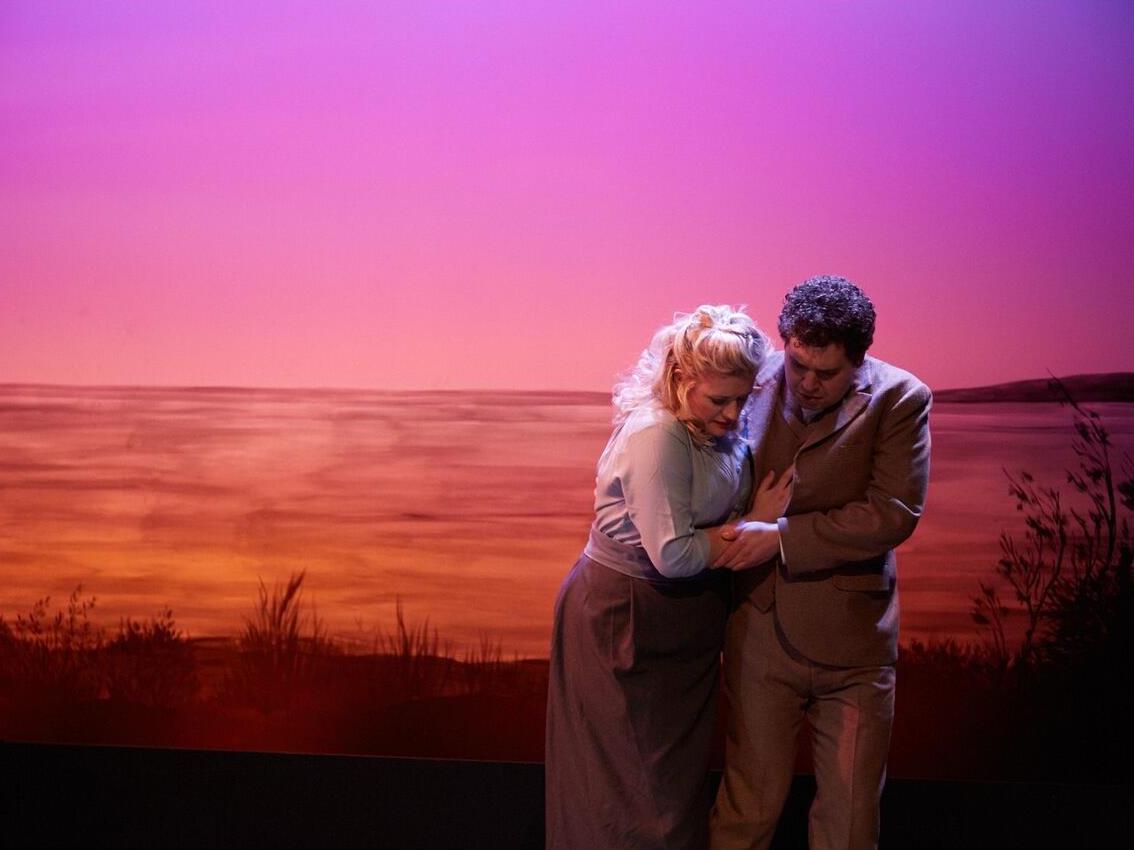Photo by Kris Washusen
It’s 1910 in Melbourne and British/Australian composer GWL Marshall-Hall composes a 90-minute, one-act opera called Stella for full orchestra, five soloists and choir. Set in ‘a bayside suburb’ – from his letters we now know that he had Rickett’s Point overlooking Port Phillip Bay in mind – it is today regarded as the first opera situated in Melbourne. Two performances took place in Her Majesty’s Theatre in 1912 and further abbreviated performances took place in London two years later. Apart from excerpted performances with piano, the work has been shelved ever since in the Grainger Museum. Lyric Opera’s current restoration for its Australian Opera Series is therefore the first time the work has been heard in 103 years, largely the work of the company’s Artistic Director, Pat Miller, who has spent a year creating a version for chamber forces (an ensemble of 16) from original materials.
Marshall-Hall was an unusual and always controversial character. He arrived in 1891 to be Melbourne University’s inaugural Ormond Professor of Music and established the Melbourne Conservatorium of Music three years later. In England he left an aesthetic debate raging between the ‘Wagnerites’ in one corner and the British school of composers Stanford and Parry in the other. Bohemian and atheist Marshall-Hall, who had studied in Berlin, most certainly was in Wagner’s corner.
In 1898, his published book of poems, in a gold embossed leather cover with the mischievously provocative title Hymns Ancient and Modern, caused a bitter scandal. Melbourne’s ecclesiastical establishment weighed in with accusations of pagan fantasy and sexual immorality. The Argus accused him of ‘lewdness, animalism, lasciviousness and anti-clericalism’. His friendships with other bohemians, particularly the artists of the Heidelberg School, Streeton, Roberts, and the Lindsay brothers did not help his social reputation around College Crescent.
Despite the highest ideals for the new Conservatorium and a successful track record, Marshall-Hall was dismissed from his tenured position. The dispute continued to rage embarrassingly and in 1914 the University reinstated him. However, he died soon afterwards following an appendectomy. Today his statue rather uncomfortably springs from a bed of flowers outside Melba Hall. Stella perhaps can be seen as an enactment of all of this: social piety versus bohemian freedom, Melbourne’s stuffy Federation establishment versus the encroachment of 20th-century libertarian values and ideologies.
So what is the music like? Over some 90 minutes the score contains many ideas (far too many in fact) ranging from Puccini, particularly La Bohème (1896) through to Victorian parlour music. Now and again there are moments of originality and beauty: Stella’s aria ‘O Stars’ – which compares the natural freedom of the stars with her domestic and moral entrapment – is only three minutes long, but memorably still and tender, and there is a finely crafted quintet towards the end of the work.
This week I saw the dress rehearsal and first performance. The story is as follows: a young and attractive domestic nurse, Stella lovingly cares for the sick child of Mrs Chase and falls in love with the doctor, Dr Noel Kirke. She is horrified to meet the city’s mayor, Chamley, with whom she has had a past inappropriate relationship, and he is just as mortified to see her. Reverend Weldon hovers, trying to maintain the moral high ground. The threat of discovery drives Stella to suicide by overdosing on a poisonous medicine prescribed for the sick child. On hearing an explanation of her past, the doctor forgives her, stating (in the same manner as Schoenberg’s Transfigured Night, 1899) that their love will transform and be renewed. But it’s too late. Stella is already succumbing to the effects of the poison. A long dying scene (‘Tell me again how much you love me’ etc) is interrupted by the Social Purity Society piously singing an offstage hymn, an ode to the sacred gifts of self-discipline and chastity. Stella finally dies amongst general dismay, alarm and shock.
Soprano Lee Abrahmsen provided a first-rate realisation of the leading role. Her voice is attractive, warm and musical; her understanding of the character complete. Caroline Vercoe was an excellent fussy and perpetually concerned Mrs Chase while young Robert Barbaro’s Dr Kirke was fresh and moving, his clear tenor conquering a couple of high ‘C’s without any difficulty. Matt Thomas was convincing as an anxious Mayor Chamley with occasional struggles in his upper and lower registers. Bible-clutching Rev Weldon was well played by Shoumendu Ganguly, both a fine singer and an interesting presence on stage. Pat Miller’s direction was first-rate with a complete understanding of the score and encouraging the very best from his ensemble of young musicians throughout.
Jessica Harris’s direction was often two-dimensional; Sam Fisher’s costumes were effective but similarly predictable. The chamber version of the work often had problems with balance, with Marshall-Hall’s effective, lush orchestration unachievable using leaner forces. The libretto (also by Marshall-Hall but adapted by Pat Miller) has fundamental flaws particularly with regard to character development.
Rob Sowinski delighted us with a rich and subtle lighting of Mattea Davies’s beautiful painted set evoking a washed, bleached and windswept Beaumaris beachscape, based on a Roberts painting, framed by a simple outdoor strung washing line and solitary, wooden veranda posts.
Well worth seeing.
Rating: 3 stars out of 5
GWL Marshall-Hall’s Stella
Lyric Opera of Melbourne
Conductor/Artistic Director: Pat Miller
Costume Designer: Sam Fisher
Technical Operator: Hayley Fox
Design Associate: Mattea Davies
Director: Jessica Harris
Repetiteur: Jane Matheson
Production Manager: Annie Ried
Lighting Design: Rob Sowinski
Lee Abrahmsen as Stella Winton
Robert Barbaro as Dr Noel Kirke
Shoumendu Ganguly as Rev Weldon
Matt Thomas as Mayor Chamley
Caroline Vercoe as Mrs Chase
David Williamson Theatre, Prahran
25-30 September





